

Monday 5th August 2024 - 1pm









Monday 5th August 2024 - 1pm






MONDAY 5th AUGUST 2024 - 1pm
Outer Bald Blair - Guyra, NSW
• 150+ Angus Bulls & 150 EU Commercial Heifers •
104 Rising 2yo and 50 - 60 Yearlings
Bull inspections from 10am
Morning tea, Barista Coffee & Smo-King Barbeque Lunch
Dick Whale
Independant Breeding & Marketing Service Mob: 0427 697 968
Dan McLennan Mob: 0428 397 728
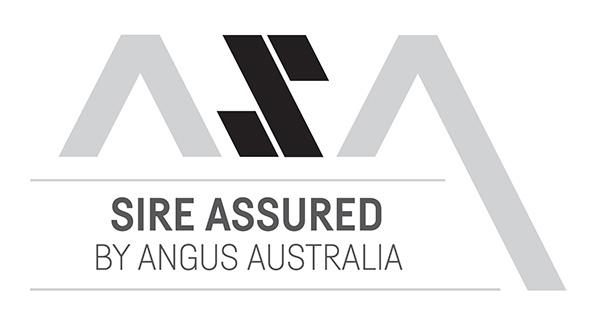

Terry Williams - Mob: 0448 427 004
Paul Harris - Mob: 0428 600 510
On behalf of Prue and our family I extend a warm invitation to join us at our 40th Annual Sale. Our sale day experience involves an exceptional home made morning tea, barista coffee, and mouth watering brisket burgers cooked low and slow. A reminder of our open day on Sat Aug 3rd where all bulls and heifers will be on display.
The past 12mo has been challenging seasonally, which when running a high stocking rate means key decisions had to be made. For us, agistment to Wagga and Adelong, early weaning of our commercial herd, and cows on the road provided the necessary adjustment to balance our grass and mouths. This now leaves us in the position to calve at full capacity in coming months, a big short-medium term goal. Despite the tough spring we achieved >92% PTIC in our 6 week heifer & cow joining. For those pasture budgeters, we are at 2150 kg/dm/ha at June 1. Autumn has been kind, with good rainfall, mild temperatures, and very few frosts. I expect a big spring with normal to above average rainfall through until Christmas.
My genetics trip to the US in June/July last year was powerful. It built upon my previous trips and resulted in several high conviction sires to use in coming years that meet our criteria for exceptional structure. More on page 5. On May 2nd we welcomed 130 beef producers to our workshop on commercial profitability and longevity (page 6 & 7), and last month Prue and I had a wonderful week at Beef 24 in Rockhampton where the outlook for cattle prices is very bullish. We met with many key industry players, and strengthened our knowledge of the role of Angus genetics in the north.
Looking ahead to this year’s sale, we step up our offering to over 150 Bulls and 150 heifers. This is result of carefully considered growth in recent years and ET calves coming through from cows with exceptional Stayability. We strive to breed Bulls that last and cows that stay. (See Page 3)
Genetics aside, it’s been a productive 12mo on farm with upgrades to fencing, laneways, tree planting, water infrastructure, bigger mobs and smaller paddocks, homestead and cottage renovations, progress on our soil carbon project and ongoing upgrades to our pastures. Our enterprise shift, driven by benchmarking data, toward more cattle and less sheep continues. Our newsletters and the telling of our story are a credit to Anna Kemph and her many skills, and the changes in the paddock day to day are a result of Dan & Cody’s willingness to try new things. We have a great team.

We step up our offering to 150+ Bulls this year creating a great buying opportunity for our clients to secure industry leading genetics. Of the 150 offered, around 100 are 2yo complimented by 50-60 yearlings. This volume is result of carefully considered growth in our stud herd in recent years assisted by ET calves coming through from cows selected for exceptional Stayability and progeny history. All Bull lots will be videoed in early July and available for viewing on our website and Auctions Plus soon after. On farm inspections are welcome anytime, and our open day will be held on Sat Aug 3rd (2 days prior to the sale). The 100 odd 2yo bulls sees the last run of highly proven genetics whilst the 50-60 yearlings are an exciting transition toward new outcross genetics from our extensive trips both domestically and to the US in recent years. We only use sires we have inspected ourselves reflecting our fastidious focus upon structure. Around half the bulls offered are heifer suitable. We provide lot comments on each 2yo bull that I think is of value from our own performance recording and herd data collection, including maternal. Please take advantage of the structural scoring done independently by Dick Whale of IBMS, which is displayed on each lot as well as being submitted to TACE. I recommend giving at least as much consideration to structural scores as to EBV’s, which is exactly what we do ourselves.
In terms of sirelines, around 30 Bulls are by standout home bred Sydgen Enhance sons Q42 & Q164, 30 sons/ Grandsons of Rennylea Intensity, 25 sons of Wattletop Q41, and a mix of 2yo sons by highly proven sires Stoney Point Nolte, Chiltern Park Moe and Paratrooper – many of which we used ourselves as yearlings last spring. In the yearlings the new genetics of note are by 316 son RR Endeavor, Tehama Patriach, Dunoon R760 and R788 and Clunie Range Plantation – all of which are an outcross for our own commercial herd and that of our clients.
Our genetic offering in our 2024 sale illustrates the value in balanced Angus breeding and genetics that thrive in commercial conditions and drive profitability. As always, the bulls are the outcome of a female herd run under strict commercial conditions, in large mobs, with stocking rate pressure, tight 6 week joining, no second chances on fertility and zero tolerance for poor structure..

We have included three farms in our soil carbon project with baseline soil testing completed in November 2022, and our first retest planned in 2027. We are optimistic of improved future outcomes for our livestock, pastures, soil biology, water infiltration, drought preparedness, and business performance. If this space is of interest to you we are happy to share our learnings anytime. This space can be very confusing and I have spent a lot of time on it, so if you are struggling with it all feel free to give me a call anytime. I have found the entire team at Precision Pastures in Armidale extremely knowledgeable and helpful in our journey thus far.
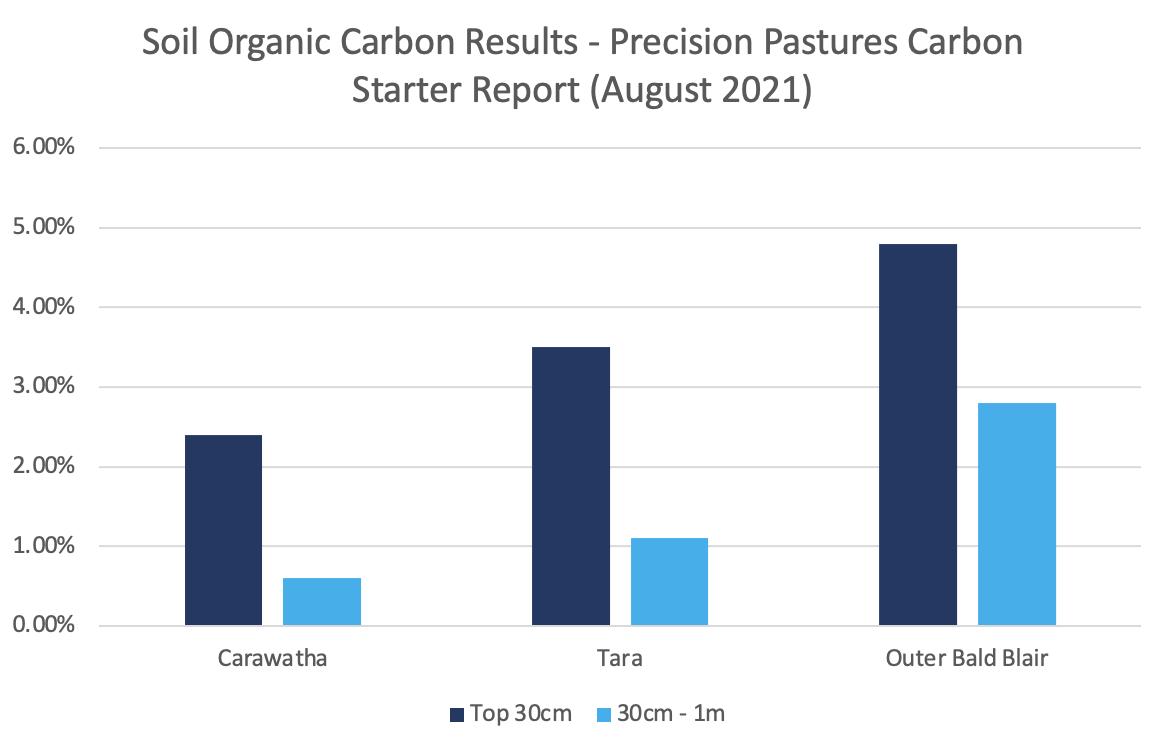



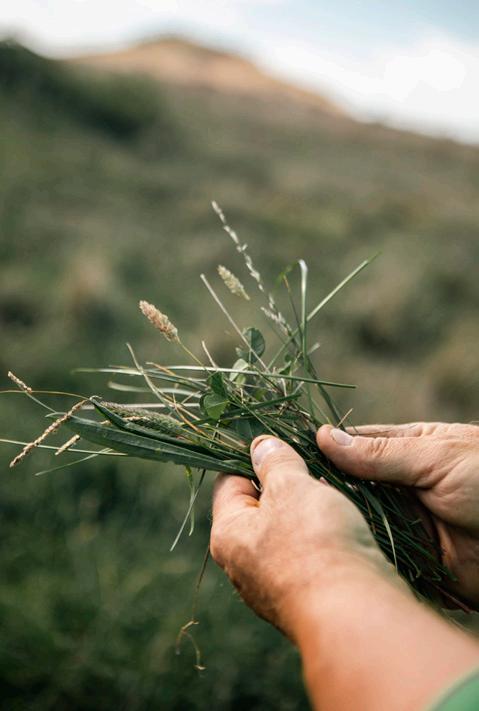
Last June/July I visited the US for the first time post Covid with Dick Whale visiting many of the leading US Angus herds. It was a very powerful trip, and built upon my previous visits thus deepening my understanding of the US genetic base and resulted in several high conviction sires to use and share with our clients in coming years.
We use a mix of US and Australian genetics in our Spring AI & ET programs. A key part of our role is to always be researching new genetics and only use Bulls where we have personally inspected the bull, his progeny, and ideally his dam and daughters in production. That’s why we make time to travel both domestically and to the US and do such in depth homework. A real bonus is that we meet wonderful people and form strong relationships with like minded passionate breeders.
A few highlights of the trip were T/D Angus in Nebraska who bred T/D Doc Ryan 049 who we have imported semen to use this spring. We inspected Doc Ryan’s Dam, hundreds of calves and also many daughters in production. They really stood out. Doc Ryan is a son of Casino Bomber who along with Sydgen Enhance were the two high conviction bulls I found on my previous US trip. We have used Enhance widely in recent years with sons topping the sale and breeding on well. The Baldridge female sale was another real highlight where the full sister to Sterling Pacific 904 sold. Sterling Pacific was a standout bull on type and structure, and we visited owners T-Bone Angus and saw several generations of calves. We used him heavily in our AI last spring with calves due here next month. Other Stud’s of note were Hoffman, Coneally, Poss, Hoover, Mocgk (owner of Sydgen Enhance), Mohen, Raven and Vermillion (owner of Casino Bomber). I have notes on each farm visit and what genetics stood out for those interested in a discussion anytime.






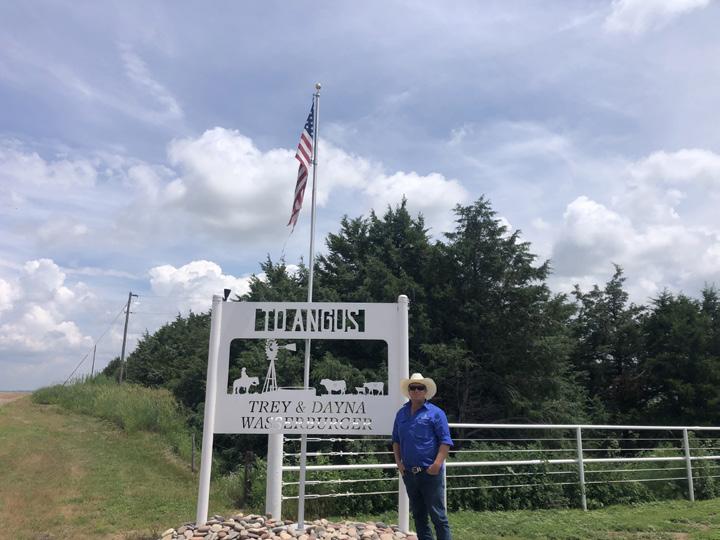


On May 2nd, we welcomed 130 beef breeders to Outer Bald Blair for a workshop specifically targeting the core drivers of profitability and longevity in a commercial beef enterprise. Speakers included John Francis from Agrista, Dick Whale of IBMS, Scott Wright, CEO of Angus Australia, and ourselves.
John Francis challenged the crowd when addressing how to identify opportunity and improve profitability. Through Glenavon’s own commercial herd benchmarking data, John explained the factors influencing cost of production. Most importantly, how utilising all of your feed (adding more animals), and how fertilizer spend (growing more grass) can materially lower cost of production and drive higher profitability. A highly relevant comparison of a weaner system vs a feeder system was explained to the crowd. A feeder system consumes 25% more feed yet delivers a far superior financial outcome by delivering higher production measured by kg beef /ha.
Glenavon’s commercial beef data clearly illustrated this point – in the 3 years selected where our beef production exceeded 200kg lwt/ha, cost of production (CoP) fell below $2/kg/lwt and to as low as $1.18 (2017/18), $1.88 (2020/21) and $1.29 (2021/22). The years with production below 200kg lwt/ha, saw CoP rise to above $2.00 kg lwt. The average cost of production of benchmarking participants is currently approaching $2.50/kg/lwt.
Beef enterprises are scalable in that 80% of costs are overheads (fixed) when compared to a sheep enterprise where overhead and enterprise costs are 50/50. Adding more animals in a beef enterprise allows a bigger base to share this overhead cost, driving cost of production down.
A comparison of our commercial beef enterprise vs prime lamb (historically around 10,000 DSE each), clearly showed superior returns in the beef enterprise. We have scaled up our commercial cattle and reduced our prime lamb operation in recent years.

John challenged the crowd to start measuring something, and articulated if you do one thing, measure cost of production.
Dick’s presentation focused on stayability (females) and longevity (Bulls). Stayability is defined as the ability of a Sire to produce daughters that remain in your Herd until at least 6 Years of Age. Longevity is defined as the ability of a bulls to remain in your herd – ie how many years he lasts. This is something we can select for. Stayability is the first and most important criteria for Glenavon donor cow selection which Dick highlighted as a point of difference in the industry.

Attendees learned of available tools and best practice for assessing structural soundness and translating it into genetic selection criteria. A practical demonstration of structural scoring on a selection of rising 2 year old Glenavon Bulls was provided. Discussion then focused on how this structural data is submitted to TACE, and spoke to their correlation with structural EBVs. The importance of investing in genetics that align with longevity, illustrated via data showing the calf cost for a commercial beef enterprise is driven by the longevity of the bull, not the price paid.
Scott Wright provided attendees with an update on the breed society’ plans for a Functional Longevity EBV in Australia, derived from female inventory data.
I shared our own data on bull breakdowns during joining. The data captured our shift from a single sire mating toward using teams of bulls with larger mobs of females. Despite doubling the number of commercial females joined, bull breakdowns have more than halved as a ratio of females joined, falling to just 7% in our 2023 6 week spring joining. The single biggest driver of this reduction has been management – specifically identifying dominant bulls in the first cycle and removing them after 3 weeks before they injure themselves due to over use. These bulls, once removed, make a near full recovery within weeks. The remaining bulls left in the mob, if kept at around a 2% ratio of females that are left to be served, easily get the job done. We have virtually eliminated injuries from fighting in the last 2 weeks of joining.
In our most recent Oct/Nov (6 week) joining we achieved a PTIC rate of 92% across all commercial heifers and cows in a tough season.
Key Takeaways: (Glenavon joining tips)
• Bull management - 2 - 3% ratio to start
• Remove dominant Bulls after 3 weeks - rapid recovery (especially with yearlings)
• Huge time/efficiency benefit (fewer mobs to check)
• Works well with rotations (pasture recovery)
• Large mobs requires infrastructure and skills.

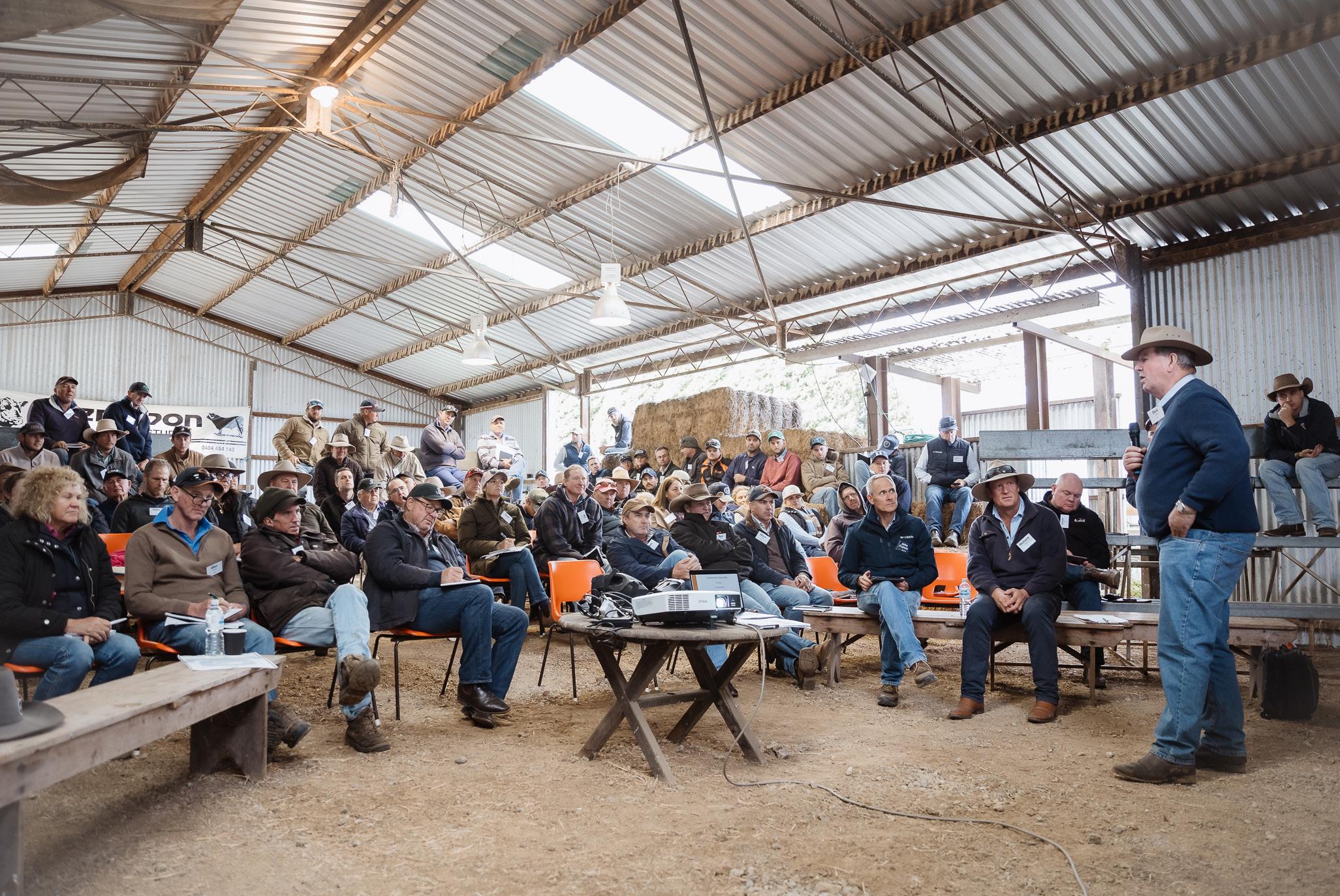
We take the time and expense to be very thorough with our performance recording which is submitted to TACE, beginning with calves being weighed and tagged at birth. They are weighed again at 200, 400 & 600 days. Mature cow weights are collected at weaning (with calves 200dw). All animals are scanned at 20mo for EMA, IMF, Rib & Rump fat. Scrotal measurements are collected at 600days (or just prior to sale for yearlings). Genomic testing and parent verification is conducted also at 200dw/weaning. We test for all major genetic conditions. All bulls are PI-Antigen (ear notch test for pestivirus) tested clear. All structural assessments are done independently, including coat scoring and all bulls are fully vaccinated including tick fever.
Whilst we include some raw data in this catalogue, such as actual birthweight, 600dw and scrotal, and all structural scores, if you are interested in more please reach out. We are very happy to share all raw data including carcass scans and follow it up with a call if needed to explain how it sits in the contemporary group.
All sale Bulls have been assessed by Dick Whale from Independent Breeding & Marketing Services. Structural scores are submitted to TACE and printed in this catalogue. For an explanation of Structural assessment please see pages 12 & 13. Structural scoring of Yearling bulls is done just prior to the sale and available on sale day as a supplementary sheet.
Reproductive Examination
All rising 2yo bulls have passed a physical examination for reproductive soundness by Peter Brown and Nathan Kruidenier of Bovine Breeders on 30/4/24. All bulls were semen tested by crush side examination AND submitted for morphology testing. Yearling bulls had the same examination and morphology testing on 9/7/24. Only those bulls with satisfactory results are offered for sale.
The latest EBV’s are supplied with each lot. For an explanation of EBV’s please see page 15.
We include actual birth weights for each lot. By way of reference, the average birthweight for the T bulls in the sale catalogue is 40.6kg. We find actual birthweight is often a better guide than an EBV, or useful to be used in conjunction with the EBV for this trait. We nominate those low birth weight lots in the catalogue we feel would be suitable for maiden heifer joining. There are also many bull lots with birth weight EBV’s around breed average with positive calving ease that we are more inclined to use than selecting for low birth in isolation as we feel that continually using low birth weight bulls contributes to small pelvic heifers and heifer calving problems medium-longer term. We advise selecting for bulls with long necks and laid in shoulders for heifer use.
Cattle inspections can be arranged before the sale. Catalogue details are available on the Angus Australia website www.angusaustralia.com.au, www.glenavonangus.com, and Auctions Plus.
The following lots are mates: 1 - 35, 36 - 58, 59 - 82 83 - 146 (Yearlings) 147 - 168


AQIS Accreditation: ABC-015-NSW
Phone: 0428 783 833
B/h (02) 6775 1718
Email:peter@bovinebreeders.com.a u nathan@bovinebreeders.com.au
30th April 2024
This is to certify that on the 30th April 2024 Glenavon rising 2yo Sale Bulls were subjected to a crush side semen assessment and examined for reproductive and structural soundness, and passed with satisfactory results relative to age. All bulls were submitted for morphology testing and only those with satisfactory results are offered for sale.
The assessment above, both crush side and Morphology, was conducted on Glenavon Yearling Bulls on 9th July 2024

Peter Brown PRINCIPLE
Nathan Kruidenier PRINCIPLE
All sale bulls will be penned at “Outer Bald Blair” by 10.00 am on sale day for inspection. Private inspection can also be arranged by contacting Richard Post on 0404 454 143, or the selling agents (see page 1 for contact details).
All Bulls offered for sale have been semen & morphology tested, DNA sire verified and Genomic tested, tested PI free and passed a physical reproductive examination prior to sale by Bovine Breeders. All bulls have been given tick vaccine as yearlings.
In May/June all Sale Bulls were inoculated for Vibriosis, Leptospirosis, Pestivirus (BVDV) and for 3 Day Sickness. All Bulls received a selovin, Flukazole C and 7 in 1 Booster, in May. No Bulls have had their feet trimmed. We are hard on structure and type for the purpose of your bulls longevity and the generations of progeny that follow.
We have done everything possible to present sound, fertile, healthy bulls for sale. All Bulls are guaranteed fertile and have passed a rigorous Physical inspection. All Bulls have been semen tested and examined by Peter Brown and Nathan Kruidenier from Bovine Breeders prior to the sale. We do not give refunds for infertility caused by injury or disease contracted after leaving the property. (Your Bulls should be properly managed and not let them become OVERWEIGHT. This can cause excess hoof growth,lameness and foot abcess. They should be kept in condition score 3 until 6 weeks before joining, when they can be put onto better pastures. Foot Abscess is a disease which can easily be treated if caught in the early stages of infection. It can be prevented by good management). It is the Purchasers responsibility to insure against those events. Any claims must be accompanied by a Veterinary Certificate. We do advise all bull purchasers to Insure their Bulls for 12 months against loss of use.
A 3% rebate is offered on bulls to an introducing agent who attends the sale and signs the Buyers Instruction Slip (on page 79). Otherwise a 2% rebate to outside agents for bulls. Agents must nominate potential purchasers in writing 24 hours prior to the sale. To be eligible for Rebate Agents must settle for purchases within 7 days of receipt of invoice. The rebate conditions will be strictly enforced.
Transport
Ample transport will be available on sale day. We recommend; Bruce Turner from Betts Transport Phone Bruce on 0428 658 402 or Office 02 6778 0477; and Peter Kratz Transport Ph. 0412 667320 or a/h 6772 5597.
All registered stock are eligible for transfer. Please ensure correct name and address is printed on the Buyers Instruction Slip (see page 79 of catalogue). PIC Numbers, Phone Number & email address must be entered on to Registration Form. To pre-register, please see page 61.
Refreshment
Morning Tea, Barista Coffee and Lunch will be provided from 10.30 am. Once again our sale lunch has the big smoker fired up cooking low and slow all morning, with thanks to Darren and Sigourney of Smoking BBQ.
Disclaimer
Every care has been taken in the compilation of this catalogue to ensure the accuracy of information supplied. However, no responsibility will be accepted for any errors which may have occurred.
Cattle producers using Angus Bulls are making more money than those who don’t. But that doesn’t apply to just any Angus Bull. Don’t be caught with UNREGISTERED bulls with unknown backgrounds and without Angus Group Breedplan figures. Progeny of unregistered bulls are INELIGIBLE FOR CAAB ™ and ASSURED ANGUS ™ tags. As a service to bull buyers, the Angus Society has introduced a Quality Assured catalogue, giving buyers confidence the bulls are registered and the catalogue truly reflects official data. Look for catalogues carrying this logo and become part of the Angus profit system. For more information contact The Angus Society (02) 6772 3011 or visit the website: www.angusaustralia.com.au.
This is information for bull buyers about the recessive genetic conditions, Arthrogryposis Multiplex (AM), Hydrocephalus (NH), Contractural Arachnodactyly (CA) and Developmental Duplications (DD).
All animals, including humans, carry single copies (alleles) of undesirable or “broken” genes. In single copy form, these undesirable alleles usually cause no harm to the individual.
But when animals carry 2 copies of certain undesirable or “broken” alleles it often results in bad consequences. Advances in genomics have facilitated the development of accurate diagnostic tests to enable the identification and management of numerous undesirable or “broken” genes.
Angus Australia is proactive in providing its members and their clients with relevant tools and information to assist them in the management of known undesirable genes and our members are leading the industry in their use of this technology.
AM, NH, CA and DD are all recessive conditions caused by “broken” alleles within the DNA of individual animals. When a calf inherits 2 copies of the AM or NH alleles their development is so adversely affected that they will be stillborn.
In other cases, such as CA and DD, calves carrying 2 copies of the broken allele may reach full-term. In such cases the animal may either appear relatively normal, or show physical symptoms that affect their health and/or performance.
Carriers, will on average, pass the undesirable allele to a random half (50 %) of their progeny.
When a carrier bull and carrier cow is mated, there is a 25% chance that the resultant calf will inherit two normal alleles, a 50% chance that the mating will result in a carrier (i.e. with just 1 copy of the undesirable allele, and a 25% chance that the calf will inherit two copies of the undesirable gene.
If animals tested free of the undesirable gene are mated to carrier animals the condition will not be expressed at all. All calves will appear normal, but approximately half (50%) could be expected to be carriers.
DNA-based diagnostic tests have been developed which
can be used to determine whether an individual animal is either a carrier or free of the alleles resulting in AM, NH, CA or DD.
Angus Australia uses advanced software to calculate the probability of (untested) animals to being carriers of AM, NH, CA or DD. The software uses the test results of any relatives in the calculations and the probabilities may change as new results for additional animals become available.
The genetic status of animals is being reported using five categories:
AMF
AMFU
Tested AM free
Based on Pedigree AM freeAnimal has not been tested
AM_% _% probability the animal is an AM carrier
AMC
AMA
Tested AM-Carrier
AM-Affected
For NH, CA and DD, simply replace AM in the above table with NH, CA or DD.
Registration certificates and the Angus Australia webdatabase display these codes. This information is displayed on the animal details page and can be accessed by conducting an “Database Search” from the Angus Australia website or looking up individual animals listed in a sale catalogue.
Your decision on the importance of the genetic condition status of replacement bulls should depend on the genetics of your cow herd (which bulls you previously used) and whether some female progeny will be retained or sold as breeders.
Most Angus breeders are proactive and transparent in managing known genetic conditions, endeavouring to provide the best information available. The greatest risk to the commercial sector from undesirable genetic recessive conditions comes from unregistered bulls with unknown genetic background. The genetic condition testing that Angus Australia seedstock producers are investing in provides buyers of registered Angus bulls with unmatched quality assurance.
For further information contact Angus Australia (02) 6773 4600.
All Glenavon sale bulls underwent the Genetic Type Summary (GTS) and structural Assessment prior to sale. All bulls catalogued were considered acceptable for soundness and muscling. If any potential buyers wish to discuss these bulls prior to the sale, please contact Dick Whale on mobile 0427 697 968 or Richard Post on 0404 454 143.
How to use: The Beef Class Structural Assessment System uses a 1-9 scoring system for feet and leg structure:
• A score of 5 is ideal.
• 4 and 6 show slight variation from ideal, but this includes most animals. Any animal scoring 4 and 6 would be acceptable in any breeding program.
• 3 and 7 shows greater variation, but would be acceptable in most commercial breeding programs, however seedstock producers should be wary.
• 2 and 8 are low scoring animals and should be looked at carefully before purchasing.
• A Score of 1 or 9 should not be catalogued and are considered immediate culls.
For feet and leg assessment, animals need to be on a hard, flat, and even surface where animal can move/ stand naturally.
Stature – Evaluation of animals for maturity pattern and frame size. A score of 25 is average (Frame 5.5). This score may be influenced by age of dam, nutrition, etc. Scores greater than 25 indicate larger framed, later maturing cattle.
Capacity – Evaluation combines spring of rib, and width of chest floor. Scores higher than 38 indicate a bull with greater capacity.
Body Length – Evaluation of body length from point of shoulder to pin bone. Scores higher than 25 indicate longer body length.
Muscle Score – is the muscularity devoid of subcutaneous fat. Higher scores indicate animals with higher yield and dressing percentage attributes. Scores 30 = C, 35 = C+, 40 = B-, 45 = B.
Doability – is the ability of an animal to deposit fat in fat depots, relative to their peers under a common management regime.
Sheath Attachment
A 1-5 scoring system is used for sheath attachment. 5 is tight to the body and ideal, 1 is very pendulous and loose.
Hair Type
A 1-5 scoring system is used. 1 being slick haired and 5 is extremely coarse haired.


Stature - Evaluation of an animals frame size, based on visual assessment of the animals hip height.
Capacity - Evaluation of an animal by visual assessment combining depth of fore rib along with spring of rib and width of chest floor as well as depth of flank.
The greater the score the greater an animals capacity.
Body Length - Evaluation by visual assessment of an animals length from withers to pins.
The greater the score the greater an animals capacity.

Font Feet - Evaluation by visual assessment of an animals front feet structure.
Open Claws
Hind Feet - Evaluation by visual assessment of an animals hind feet structure.
Rear Leg Hind View - Evaluation by visual assessment of an animals rear structure.
Rear Leg Side View - Evaluation by visual assessment of an animals length and strength of pastern and foot angle.
Rear Leg
Muscling - Evaluation by visual assessment of an animals combined width of rump and hindquarter, with secondary consideration given to forearm muscling.
The TransTasman Angus Cattle Evaluation is the genetic evaluation program adopted by Angus Australia for Angus and Angus influenced beef cattle. The TransTasman Angus Cattle Evaluation uses Best Linear Unbiased Prediction (BLUP) technology to produce Estimated Breeding Values (EBVs) of recorded cattle for a range of important production traits (e.g. weight, carcase, fertility).
The TransTasman Angus Cattle Evaluation is an international genetic evaluation and includes pedigree, performance and genomic information from the Angus Australia and Angus New Zealand databases, along with selected information from the American and Canadian Angus Associations.
The TransTasman Angus Cattle Evaluation utilises a range of genetic evaluation software, including the internationally recognised BLUPF90 family of programs, and BREEDPLAN® beef genetic evaluation analytical software, as developed by the Animal Genetics and Breeding Unit (AGBU), a joint institute of NSW Agriculture and the University of New England, and Meat and Livestock Australia Limited (MLA).
An animal’s breeding value can be defined as its genetic merit for each trait. While it is not possible to determine an animal’s true breeding value, it is possible to estimate it. These estimates of an animal’s true breeding value are called EBVs (Estimated Breeding Values).
EBVs are expressed as the difference between an individual animal’s genetics and a historical genetic level (i.e. group of animals) within the TACE genetic evaluation, and are reported in the units in which the measurements are taken.
TACE EBVs can be used to estimate the expected difference in the genetics of two animals, with the expected difference equating to half the difference in the EBVs of the animals, all other things being equal (e.g. they are joined to the same animal/s).
For example, a bull with a 200 Day Growth EBV of +60 would be expected to produce progeny that are, on average, 10 kg heavier at 200 days of age than a bull with a 200 Day Growth EBV of +40 kg (i.e. 20
kg difference between the sire’s EBVs, then halved as the sire only contributes half the genetics).
Or similarly, a bull with an IMF EBV of +3.0 would be expected to produce progeny with on average, 1% more intramuscular fat in a 400 kg carcase than a bull with a IMF EBV of +1.0 (i.e. 2% difference between the sire’s EBVs, then halved as the sire only contributes half the genetics).
EBVs can also be used to benchmark an animal’s genetics relative to the genetics of other Angus or Angus infused animals recorded with Angus Australia. To benchmark an animal’s genetics relative to other Angus animals, an animal’s EBV can be compared to the EBV reference tables, which provide:
• the breed average EBV
• the percentile bands table
The current breed average EBV is listed on the bottom of each page in this publication, while the current EBV reference tables are included at the end of these introductory notes.
For easy reference, the percentile band in which an animal’s EBV ranks is also published in association with the EBV.
An accuracy value is published with each EBV, and is usually displayed as a percentage value immediately below the EBV.
The accuracy value provides an indication of the reliability of the EBV in estimating the animal’s genetics (or true breeding value), and is an indication of the amount of information that has been used in the calculation of the EBV.
EBVs with accuracy values below 50% should be considered as preliminary or of low accuracy, 50-74% as of medium accuracy, 75-90% of medium to high accuracy, and 90% or greater as high accuracy.
EBVs are calculated for a range of traits within TACE, covering calving ease, growth, fertility, maternal performance, carcase merit, feed efficiency and structural soundness. A description of each EBV included in this publication is provided on the following page.
CEDir %
Genetic differences in the ability of a sire’s calves to be born unassisted from 2 year old heifers.
CEDtrs %
GL days
BW kg
200 Day kg
400 Day kg
600 Day kg
MCW kg
Milk kg
DtC days
SS cm
CWT kg
EMA cm2
Rib Fat mm
P8 Fat mm
RBY %
IMF %
NFI-F kg/day
Doc %
Claw Set score
Foot Angle score
Leg Angle score
$A $
Genetic differences in the ability of a sire’s daughters to calve unassisted at 2 years of age.
Genetic differences between animals in the length of time from the date of conception to the birth of the calf.
Genetic differences between animals in calf weight at birth.
Genetic differences between animals in live weight at 200 days of age due to genetics for growth.
Genetic differences between animals in live weight at 400 days of age.
Genetic differences between animals in live weight at 600 days of age.
Genetic differences between animals in live weight of cows at 5 years of age.
Genetic differences between animals in live weight at 200 days of age due to the maternal contribution of its dam.
Genetic differences between animals in the time from the start of the joining period (i.e. when the female is introduced to a bull) until subsequent calving.
Genetic differences between animals in scrotal circumference at 400 days of age.
Genetic differences between animals in hot standard carcase weight at 750 days of age.
Genetic differences between animals in eye muscle area at the 12/13th rib site in a 400 kg carcase.
Higher EBVs indicate fewer calving difficulties in 2 year old heifers.
Higher EBVs indicate fewer calving difficulties in 2 year old heifers.
Lower EBVs indicate shorter gestation length.
Lower EBVs indicate lighter birth weight.
Higher EBVs indicate heavier live weight.
Higher EBVs indicate heavier live weight.
Higher EBVs indicate heavier live weight.
Higher EBVs indicate heavier mature weight.
Higher EBVs indicate heavier live weight.
Lower EBVs indicate shorter time to calving.
Higher EBVs indicate larger scrotal circumference.
Higher EBVs indicate heavier carcase weight.
Higher EBVs indicate larger eye muscle area.
Genetic differences between animals in fat depth at the 12/13th rib site in a 400 kg carcase. Higher EBVs indicate more fat.
Genetic differences between animals in fat depth at the P8 rump site in a 400 kg carcase.
Genetic differences between animals in boned out saleable meat from a 400 kg carcase.
Genetic differences between animals in intramuscular fat (marbling) at the 12/13th rib site in a 400 kg carcase.
Genetic differences between animals in feed intake at a standard weight and rate of weight gain when animals are in a feedlot finishing phase.
Genetic differences between animals in temperament.
Genetic differences in claw set structure (shape and evenness of claws).
Genetic differences in foot angle (strength of pastern, depth of heel).
Genetic differences in rear leg structure when viewed from the side (angle at front of the hock).
Genetic differences between animals in net profitability per cow joined in a typical commercial self replacing herd using Angus bulls. This selection index is not specific to a particular market end-point, but identifies animals that will improve overall net profitability in the majority of commercial, self replacing, grass and grain finishing beef production systems.
Genetic differences between animals in net profitability per cow joined in a typical commercial self replacing herd using Angus bulls. This selection index is not specific to a particular market end-point, but identifies animals that will improve overall net profitability in the majority of commercial, self replacing, grass and grain finishing beef production systems.
Higher EBVs indicate more fat.
Higher EBVs indicate higher yield.
Higher EBVs indicate more intramuscular fat.
Lower EBVs indicate more feed efficiency.
Higher EBVs indicate better temperament.
Lower EBVs indicate a lower score.
Lower EBVs indicate a lower score.
Lower EBVs indicate a lower score.
Higher selection indexes indicate greater profitability.
$A-L $
The $A-L index is similar to the $A index but is modelled on a production system where feed is surplus to requirements for the majority of the year, or the cost of supplying additional feed when animal feed requirements increase is low.
While the $A aims to maintain mature cow weight, the $A-L does not aim to limit the increase in mature cow weight as there is minimal cost incurred if the feed maintenance requirements of the female breeding herd increase as a result of selection decisions.
Higher selection indexes indicate greater profitability.
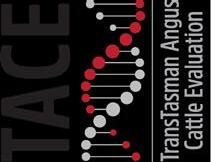
Genetic Conditions: AMF,CAF,DDF,NHF,DWF,MAF,MHF,OHF,OSF,RGF
DOB: 2/7/2019 • Registration Status: HBR
Statistics: Number of Herds: 2,
Traits: GL,BWT,200WT,400WT,600WT,SC,Scan(EMA,Rib,Rump,IMF),Genomics
DOB: 5/3/2016 • Registration Status: HBR
VTMF734 TE MANIA FOE F734SV TE MANIA CALAMUS C46SV TE MANIA DANDLOO D700# VSNF15 STRATHEWEN TIMEOUT JADE F15PV HIDDEN VALLEY TIMEOUT A45SV STRATHEWEN 1407 JADE C05PV Genetic Conditions: AMFU,CAFU,DDF,NHFU Traits:
Statistics: Number of Herds: 38, Prog Analysed: 342, Genomic Prog: 205
DOB: 10/7/2019 • Registration Status:
Statistics: Number of Herds: 1, Prog Analysed: 46, Genomic
DOB: 8/7/2019 • Registration Status: HBR
Statistics: Number of Herds: 1, Prog Analysed: 40, Genomic Prog: 40
DOB: 10/9/2017 • Registration Status: HBR SYAL178 STONEY POINT LOVIS L178SV SITZ
Statistics: Number of Herds: 8, Prog Analysed: 230, Genomic Prog: 179
BWT,200WT,600WT,SC,Scan(EMA,Rib,Rump,IMF),DOC,Genomics
Statistics: Number of Herds: 21, Prog Analysed: 239, Genomic Prog: 113
ISABEL Y69#
Genetic Conditions: AMF,CAF,DDF,NHF,DWF,MAF,MHF,OHF,OSF,RGF
USA17082311 EF COMMANDO 1366PV
EF COMPLEMENT 8088PV RIVERBEND YOUNG LUCY W1470#
NMMM9 MILLAH MURRAH ELA M9PV
Genetic Conditions: AMF,CAF,DDF,NHF,DWF,MAF,MHF,OHF,OSF,RGF
Genetic Conditions: AMF,CAF,DDF,NHF,RGF
DOB: 27/7/2018 • Registration Status:
Statistics: Number of Herds: 132, Prog Analysed: 1763, Genomic Prog: 961
Traits: GL,200WT,600WT,SC,Scan(EMA,Rib,Rump,IMF),Genomics
Statistics: Number of Herds: 1, Prog Analysed: 48, Genomic Prog: 48
DOB: 29/1/2018 • Registration Status: HBR
MILLAH MURRAH HIGHLANDER G18SV MILLAH MURRAH ELA K127SV
Statistics: Number of Herds: 323, Prog Analysed: 6300, Genomic Prog: 4540
Traits: GL,BWT,200WT(x2),400WT(x2),Scan(EMA,Rib,Rump,IMF),DOC,Genomics
DOB: 23/7/2020 • Registration Status: HBR
Statistics: Number of Herds: 1, Prog Analysed: 27, Genomic Prog: 27
Traits: BWT,200WT,400WT,SC,Scan(EMA,Rib,Rump,IMF),DOC,Genomics













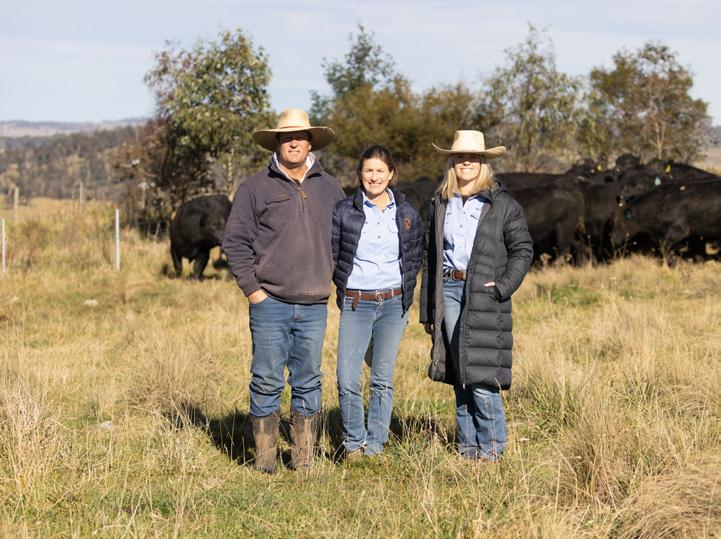








A high grading Moe son with good length and doability. Used on commercial heifers last spring. Has always been above average for growth at
growth for 600dw (in top 10% of 2yo sale bulls). A tight sheath with good scrotal.
and
Mid June 2024 TransTasman Angus Cattle
An easy doing Moe son with plenty of frame and good length to pass onto his progeny. Scanned highly for
of the group. One of the heaviest bulls for 600dw and all of this as the first calf from heifer Glenavon Gilda R111.
A bull with good frame, great growth (weiged in the top 10% of the group for 600dw) and one of the larger bulls in the draft. His dam Glenavon Evening Star P15 graded well (6) and is PTIC with her 4th calf and taken to AI on her first cycle.
Used on commercial cows as a yearling, this N479 son offers big growth being in the top handful for 600dw despite joining duties last spring. Offers great length and large scrotal. Dam Glenavon Esma M254, is PTIC with her 6th calf and has another son in the sale yearling lot 110 (U180).
Mid June 2024 TransTasman Angus Cattle Evaluation
A slick coat with great growth (top 10% for 600dw in 2yo Sale Bulls) that has good length and doability. Scanned well for rump, rib and EMA. His Dam Glenavon
with her 5th calf first cycle to AI. All her daughters have been retained in the stud.
Used in our 2023 joining as a yearling, this son of Glenavon Enhance Q164 has good growth (weighed in the top 25% for 600dw), capacity and length. Scanned well for EMA (top 25%) and has a large scrotal. Dam Glenavon Delima P288 is PTIC with her 5th calf having taken to AI on the first cycle.
with good growth (top 20% for 600dw of 2yo sale bulls). Scanned well for EMA with a large scrotal. Dam Glenavon Evening Star N165 is PTIC with her 6th calf, taken to AI in first cycle.
An easy doing bull with good length and muscle. Scanned in top 10% for IMF and top 20% for rump and rib. His dam Glenavon Copper P136 has another son in the sale with yearling U314 (lot 109) and all daughters retained in stud and PTIC.
DOB: 11/7/2022 • Registration Status:
rump, rib, EMA, and IMF (top 15% of 2yo sale bulls). Used in 2023 for joining on commercial heifers. His dam Glenavon Ann N106 is a high grading cow PTIC with her 6th calf having taken to AI in first cycle.
A slick coated Paratrooper son with large capacity and good muscling. A high growth bull (top 20% for 600dw) that was used on commercial 1st calf heifers in our 2023 joining. Dam Glenavon K254 had 8 calves with her yearling U195 also in the sale (lot 142) and daughters retained and PTIC.
A Paratrooper son with doability, muscle and capacity. Used on commercial 1st calf heifers in 2023 joining. Dam Glenavon Ann N166 a
here. An ET calf by donor cow Glenavon Evening Star J342, who is PTIC with her 11th calf. J342 was selected for donor duties due to her ability to produce calves that stay in the herd. T52 selected as a yearling for stud duties and was used on heifers in spring 2023.
Growth standout - T359 despite being younger than most of
calf of Glenavon Esma P122 who’s daughter is PTIC to calve again this


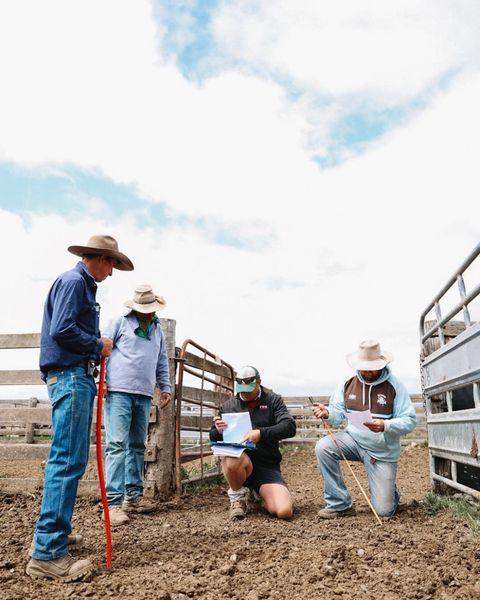

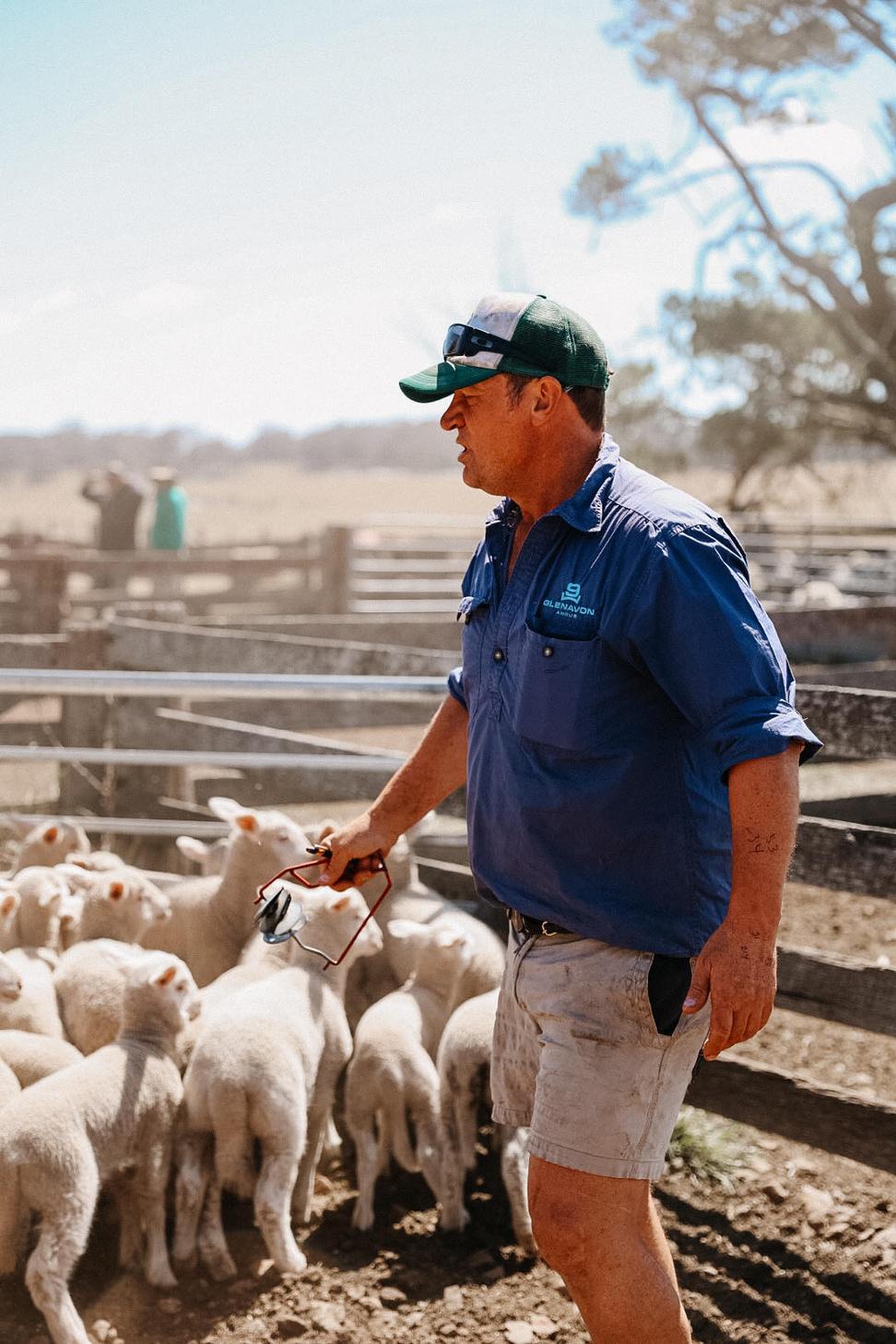












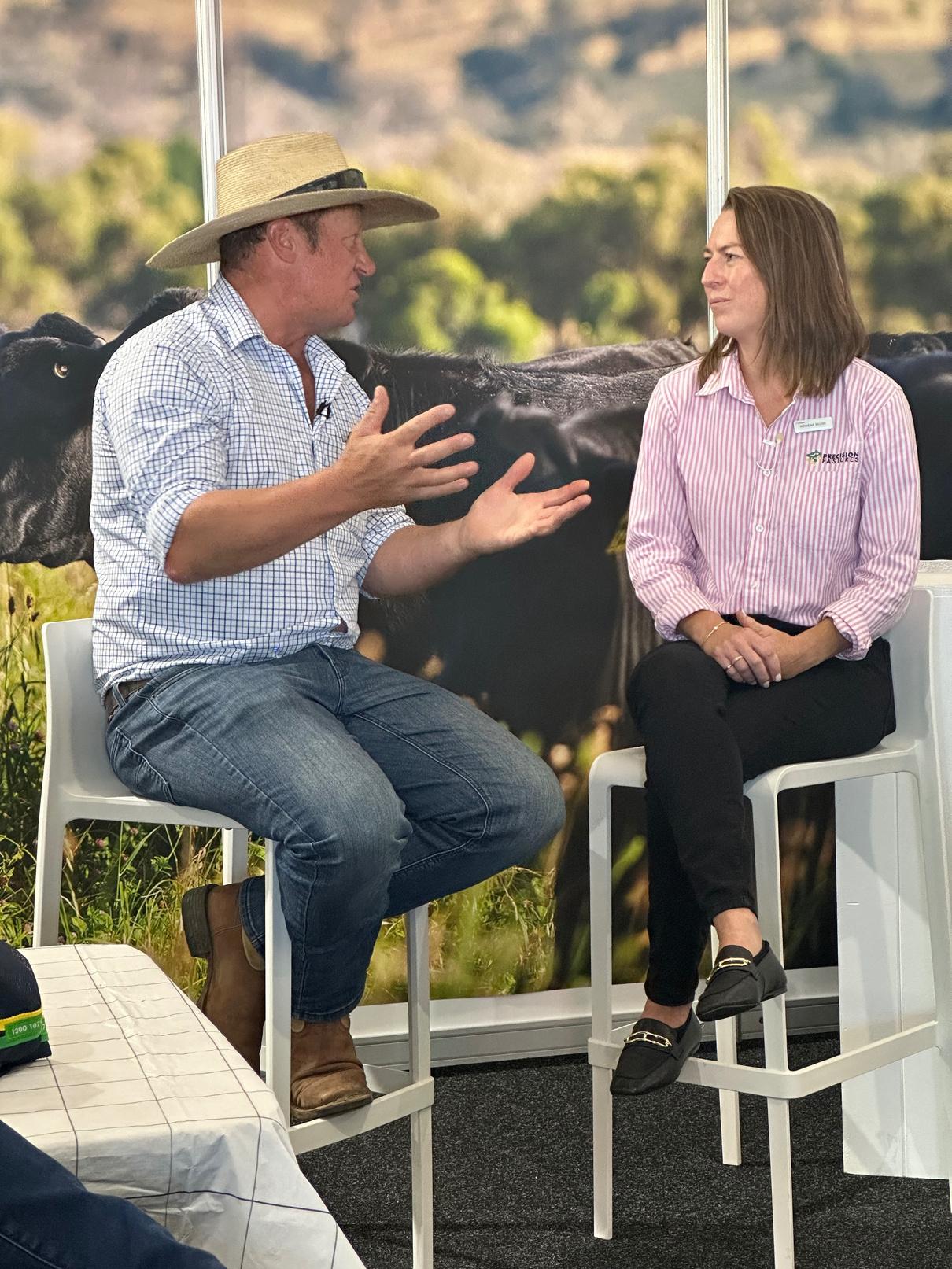
Intensity Q101 son that has good capacity and muscle. Weighed in the
and scanned in
for EMA. Dam Glenavon N78 has all heifer progeny retained in the stud and PTIC to calf again in 2024.
An easy doing Q42 son with good length. Scrotal measurement in the top 20% of the group. 3rd calf of Glenavon Delima N301 with all progeny thus far being
*females) or bulls to have made the sale.
into
This Q42 son is a standout on IMF raw scan data vs his contemporary group, which has flowed through to his IMF EBV. Also offers good length and
scrotal.
Structure(Claw Set x 1, Foot Angle x 1),Genomics A high grading bull with a big scrotal of 43cm. T124 has good capacity and muscle and scanned in top 25% for IMF. His growth and scan data reflective of EBV’s, especially as a twin to T136 (Lot 80). Dam Glenavon Evening Star M85 is known for fertility with twins again in 2023 - of which her Yearling Bull calf U305 is also in the sale (lot 144).
DOB: 4/7/2022
A slick coated, easy doing bull son of home bred Glenavon Intensity Q101 who is a standout on structure and still used in the
the T bulls for this trait. Dam Glenavon Duck N298 is PTIC with her 5th calf taking to AI on
Tight sheathed with a monster scrotal measurement to match! T348 is sired by Glenavon Enhance Q164 who’s dam Glenavon
An easy doing bull with capacity who scanned in top 25% of the group for IMF. A notable scrotal measurement of 43cm. Dam Glenavon Evening Star P332 is PTIC with her 5th calf, taking to AI in the first
A Millah Murrah Paratrooper son with standout muscle and capacity. The 7th calf of Glenavon Evening Star K14 who currently has 3 daughters also PTIC in the stud and her U heifer recently classed into the stud the herd. Strong fertility and progeny performance on maternal side.
Genetic Conditions: AMFU,CAFU,DDFU,NHFU Traits: CE,BWT,200WT,400WT, 600WT(x2),SC,Scan(EMA,Rib,Rump,IMF), Structure(Claw Set x 1, Foot Angle x 1),Genomics A wattletop Q41 son that has great muscling. His dam Glenavon Q123 PTIC in the first cycle with her 4th calf. All male progeny have passed all hurdles to make the Bull Sale with another son yearling lot 98 (U174) also in this years sale.




Great maternal history here with Dam L112 currently PTIC with her 8th calf and a history of draft leading progeny - all her daughters have been retained in the stud and PTIC to calve again this winter. T369 himself has length and capacity, also scanning well for carcass, being in the top 10% of the group for Rib, Rump & IMF.
A partrooper son with good muscle and capacity. Dam Glenavon Julia N204 is PTIC with her 6th calf, with all of her daughters being classed into the stud and preganant to calve this winter - great progeny history on the Dam side.
Another easy doing Q41 son



Sale Date: Monday 5th August 2024 at 1pm
Buyer Signature (or Agents Name & Signature)
Sale Day Phone: Craig 0448 389 025
Please email this form to Elders Armidale/Guyra dg_armidale@elders.com.au
Additional forms available from Elders Armidale/Guyra. On sale day your Buyer ID will be waiting for you!
If you are unable to attend the sale, please contact selling agents or vendor if you require phone bidding.
Alternatively visit www.auctionsplus.com.au

1

Go to www.auctionsplus.com.au to register at least 48 hours before the sale.
Fill in buyer details and once completed go back to Dashboard.
Select “Sign Up” in the top right hand corner.
Complete buyer induction module (approx. 30 minutes).
Fill out your name, mobile number, email address and create a password.
AuctionsPlus will email you to let you know that your account has been approved.
Go to your emails and confirm the account.
Return to AuctionsPlus and log in.
Select “Dashboard” and then select “Request Approval to Buy”.

Log in on sale day and connect to auction. Bid using the two-step process –unlock the bid button and bid at that price.
If you are successful, the selling agent will contact you post sale to organise delivery and payment.


Directions:
• From Guyra, take the Ebor Road for 3km. Turn left onto Wards Mistake Road for 10km then turn right at Glenavon/ Outer Bald Blair sign.
• From Glen Innes, turn left at Tubbamurra sign, go to ‘T’ intersection, turn RIGHT onto Wards Mistake Road, 6km to Glenavon/Outer Bald Blair sign on the left.
Accomodation
Recommendations:
• Glen Innes
New England Motor Lodge 160 Church Street, New England Highway, Glen Innes NSW (02) 6732 2922 www.neml.com.au/
• Guyra Shiralee Motel 125 - 127 Malpas Street, Guyra NSW (02) 6779 1380
www.shiraleemotelguyra.com. au




Sale Date: Monday 5th August 2024
Please Account Direct
Please mail my pedigree or I require transfer or registration or
To My Agent, who is AGENTS SIGNATURE
Carriers Name
Time and Delivery Date
All bulls are guarenteed fertile and are examined prior to sale day. We do not give refunds for infertility caused by injury or disease contracted after leaving the property. It is the purchaser’s responsibilty to insure against those eventualities.
Signature or Purchaser or Agent Date
NO VERBAL INSTRUCTIONS CAN BE ACCEPTED
In the interest of buyers, and to prevent the occurance of mistakes, all instructions concerning the delivery and trucking of stock must be given in writing and signed by the buyer or his representatives.
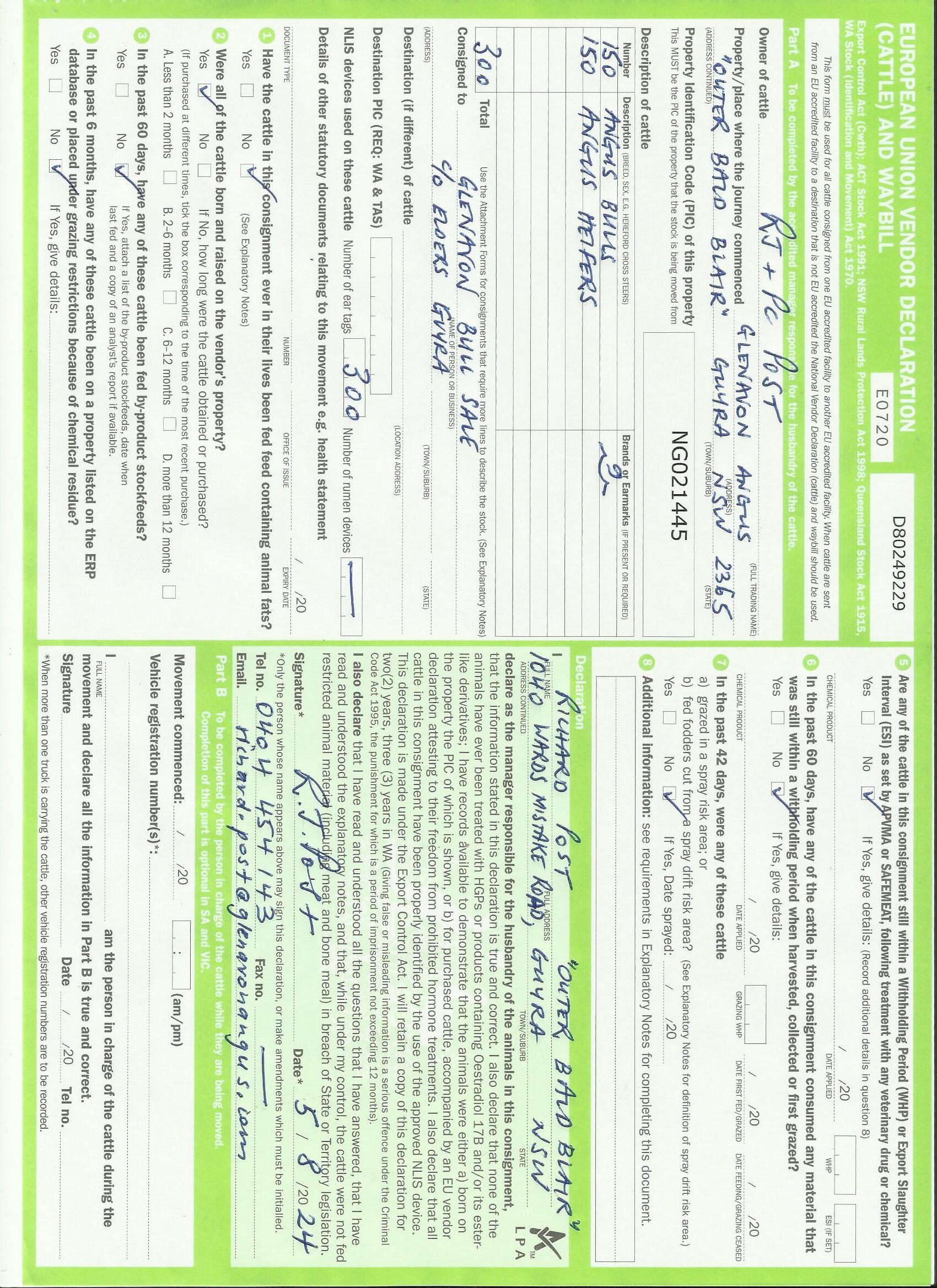







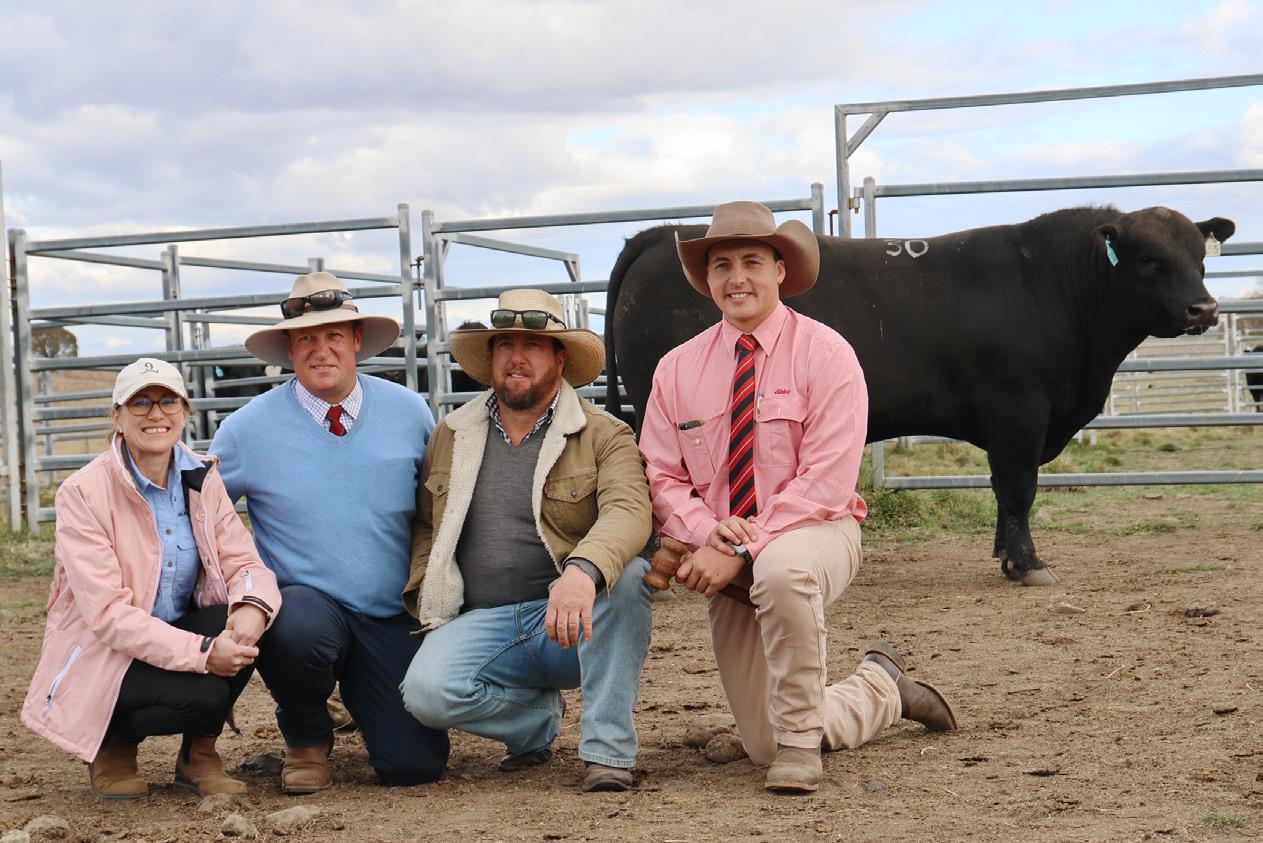


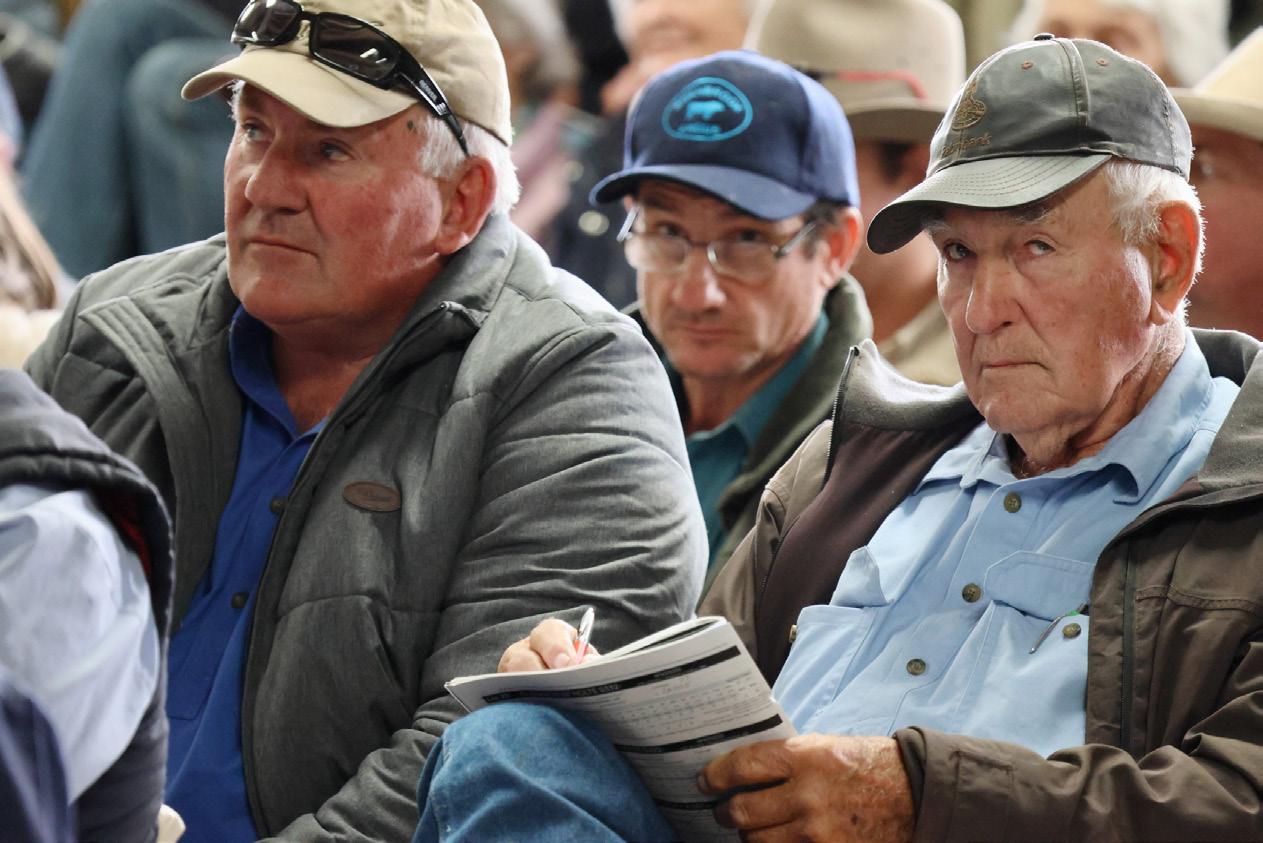
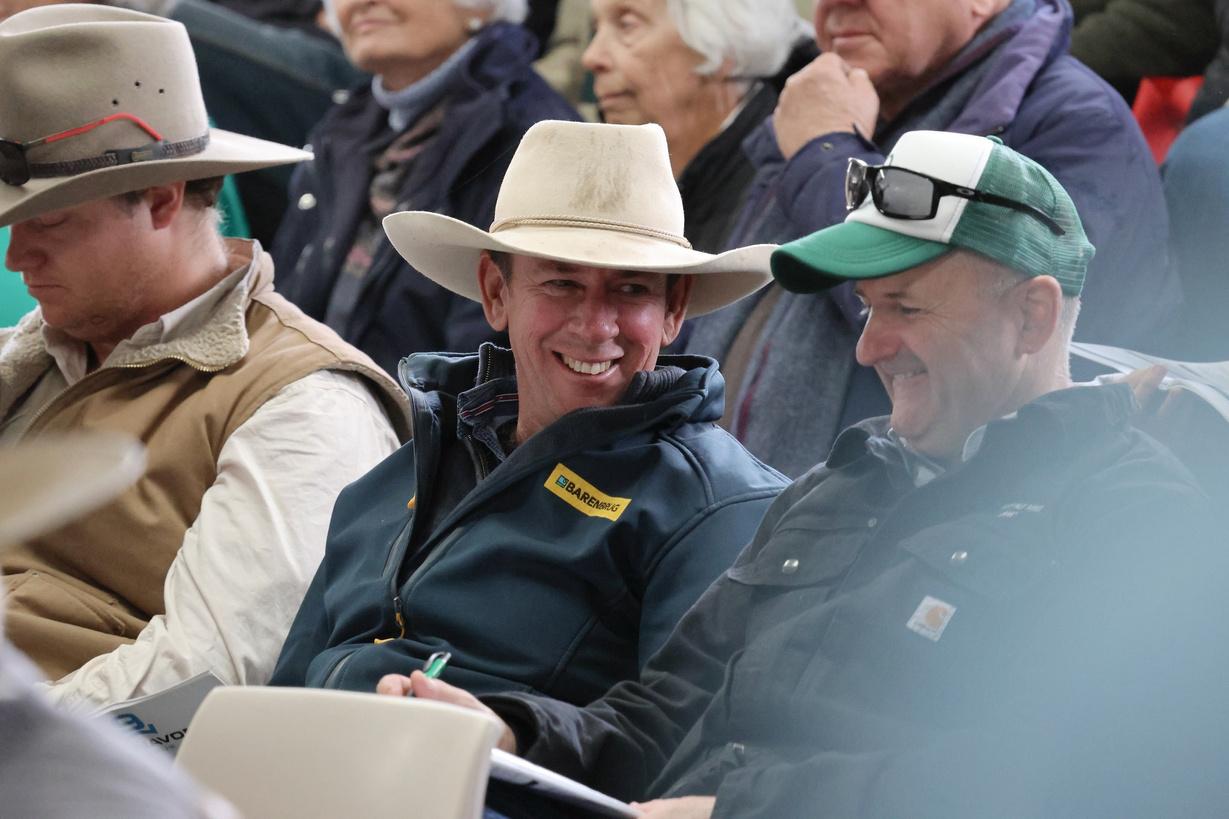


• Weighed & tagged at birth
• Weighed at 200, 400 & 600 days
• Calving Ease & Gestation Length as per Traits Observed
• Scanned for EMA, IMF, Rib & Rump Fat. Scrotal recorded
• Genomicially tested & Sire Verified
• Suspected Recessive Genetic Conditions tested
• Independently scored for structural soundness & docility
• Assessed for reproductive soundness & morphology
• Tested negative for persistently infected (PI) Pestivirus
• Fully Vaccinated, including Pestivirus, 3 day, Vibriosis & Tick Fever
• Four forms of Id; Sale lot, Visual Id, NLIS & Freeze Brand
• Coat Scored


